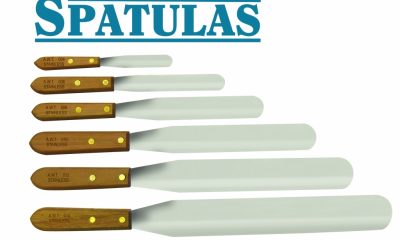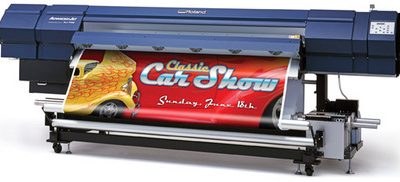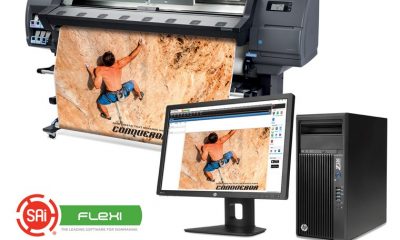Business & Industry
Published
15 years agoon
I’ve long been fascinated with exponential expansions of information and incredible rates of growth. I’ve had an opportunity over the past few months to look at these subjects, which I discussed in the September 2008 edition of Screen Printing, much more closely and consider the implications they have for garment and graphics screen printers, as well as digital printers. The speed at which knowledge expands changes everything we know about past practices and about how we run our businesses. But this isn’t unique to us. Other industries and segments are facing even greater and more radical disruptions.
Observation of the phenomenon of exponential knowledge expansion—and the dilemma exponential knowledge growth poses—has been documented in scientific papers as far back as 1981. We, of course, have been too focused on the disruptive technologies in our industry and how they’ve affected our lives to have noticed. I would like to look closely at what this means to us from the familiar perspective of learning a craft or trade, and then guarding that knowledge as a protected trade secret. I chose this perspective because our industry is notorious for harboring such a condition.
Craftsman-guild model
When knowledge was difficult to obtain and books were nonexistent, the trades and crafts protected their value by keeping their methods secret and passing knowledge by word of mouth. This is where the term trade secret originated. While the term most likely comes from Western Europe in the 1300-1400s, the first evidence of trade guilds goes back as far as the Dark Ages, around 800 AD. More importantly, knowledge was very rare and if you had it, you protected it and did not share it for risk of losing your advantage. If you were the only one who had it, you would have value and you would always have work.
This approach to knowledge was based on scarcity. During this period it was indeed possible to learn every recorded piece of knowledge—a situation common among scholars and monks. Knowledge was scarce and often held in higher esteem than gold.
Fast forward to today. We still operate with a Medieval mentality. We are well on our way out of the Industrial Era and are mostly out of the Service Economy and onto the Knowledge Economy. Or so we are told by the experts. Any of us who has recently been on a manufacturer’s production floor know this simply is not the case. The production workers still harbor the scarcity model and are extremely reluctant to learn new things or share what they do know. To make matters worse, they resist change in the futile hope that all of the new stuff will just somehow fade away and they won’t have to deal with it.
They are correct to some degree. Take learning digital art for instance. The transition over the last two decades to vector-art creation caused analog artists to completely abandon their traditional drawing and painting methods and learn a new way of creating art—a way that’s easier for the computer to address, but harder for the creator to adjust to. In fact, the interface with the computer has been anything but creative and intuitive. That’s all changing as processing power is now so vast that the entire human interface with the machine is dissolving. In just a few more years, the artists will be back to creating without the annoying and disruptive keyboard, mouse, and computer interface to spoil their creativity. Need evidence? Look at how far digital tablets have come. They are much more natural today, supporting pressure, angle, pencil, and brush behaviors.
Life cycle
The life cycle of any product or market goes through four distinct phases. They are invention, invention extension, functional substitution, and devention. As dramatically as wide-format digital technology has evolved, it is still in the functional substitution/devention phase of the lifecycle of printed graphics. Digital is the functional substitution of analog screen. Devention is where we replace the printing completely with a new technology that offers all of the visual benefits of printing, but the variability of digital—in this case, OLED wallpaper/signage. This light-emitting paper is programmable, high intensity, and variable at the speed of light. The doubling of processing and manufacturing in this segment will yield competitive productions within five to ten years, if that. Just look at how the price of flatscreen TVs has dropped in price in the last two years. You can now buy a 40-in. LCD for much less than $1000.
Abundance vs. scarcity
What does all this mean for us today? Very simply, we live in a world of opposites. When knowledge is expanding exponentially and is freely available, we’re faced with a knowledge-abundance problem. Why problem? Because if we can’t focus and implement knowledge, it will change before we can derive any economic benefit from it. If we can’t create products and have them work productively right away, we lose the opportunity.
Taken one step further, each new iteration or knowledge-improvement cycle puts us another step ahead of those who will make their living with the new technology. Geoffrey A. Moore talked of this extensively in his landmark 1995 book Crossing the Chasm: Marketing and Selling High-Tech Products to Main-stream Customers. He talked about the dilemma of the Innovators, Early Adopters, the Chasm, and then the Mainstream of Acceptance before the decline of the technology and the final adoption by the Laggards at the end of the cycle. Interestingly, the ones who made the real money were the Early Mainstream, and the Laggards. The main point is that the width of the Chasm (in terms of time) determined whether a technology would be accepted, rejected, or go bankrupt be-fore it could be adopted.
This model worked for a few years while we skirted around the pivot point of knowledge scarcity and knowledge abundance. Everything changed once we crossed that pivot point and began to deal with the economics of abundance. Now the issue is to make money as soon as the technology is available. We can no longer afford to educate our employees, bankers, management, or customers. The technology and the next round of innovation won’t wait. We must work in a frictionless knowledge environment where new knowledge flows effortlessly without the obstruction of scarcity or protection for the old ways.
Wow! That sounds extremely unlikely when we’re slapped in the face with the reality of our workforce and the educationally and linguistically challenged production personnel we have today. In an effort to keep our costs down, we hire entry-level workers who are simply incapable of learning and understanding at this level or rate. To make matters even worse, we commoditize the technology when the manufacturers of the equipment and software dumb things down so anyone can push a button and get a great result. This leads to a situation where your new $2.5-million printer delivers the same results between any two suppliers. You can’t differentiate yourself on speed, quality, or service. That leaves only the sacrificial element—price—and now no one is making any money.
This sounds bleak, but there are alternative strategies. First and foremost, we need to put the concept of trade secrets down for good. In an abundance-driven economy, scarcity is friction. Friction slows adoption and is the worst thing we could possibly do. How do we eliminate knowledge friction and still remain competitive?
The answer to this is to let go of the concept of product and process. If you’re a screen printer of P-O-P graphics, that is product and process—as are the T-shirt screen printers. We are neither. We are producers of media. We create graphics-based communication. The substrates and application methods are only tools and components. Our real value lies in how effectively we can deliver the right combination of components to satisfy the market’s requirements.
The client is looking for the total package. That may mean it’s more efficient and effective to not manufacture it yourself. It means your total value in the market boils down to two things. The first is the strengths of your exper-tise and relationships. The second is your ability to find the right strategic partners upon which to build the future economic business.
The notion that it’s a dog-eat-dog, I win you lose, zero-sum world out there represents a decades-long sales perspective—one that’s still firmly entrenched today. It’s a world built entirely on a scarcity model, as if there’s no room for the creation of new business, only trading or sharing a finite amount of existing business. Are we not concerned about declining market revenue, profit, and market share? The litho industry is a mere shadow of its former self because of the inability to change and address the abundance model. We’ve fought product and process for almost 15 years now instead of finding new ways to create new uses for graphics-based communications.
A concept such as this probably upsets a lot of people. It’s disruptive of everything they’ve known since they began manufacturing products. The vast majority of the industry is either ignorant or in denial of what’s happening. But that doesn’t mean we have to accept it. Effective strategies are available.
Solutions for the future
The most obvious place to start is to consider the nature of the media we produce. By understanding exactly what we want that media and message to do, we can then quantify and monetize it. This simply means we can figure out what it’s worth relative to the desired result. Our biggest challenge is not to figure out how to print it or what technology to use, but rather to determine the economic and social value of our message and what it actually accomplishes. We need to develop metrics we can use to actually trace the effectiveness of our offerings.
The old-school approach was based on mass markets where an advertiser pushed out a single message to the masses. This is what mass communication was all about. Again, this old model is based on the scarcity of technical knowledge and the extreme expense of the delivery methods. Typical high-capital entry examples are web printing presses, television, and radio stations. Even sheet-fed litho had huge capital barriers and massive front-end prepress costs that made short runs economically impossible.
All of that has changed with direct-to-plate, digital presses, 500+ TV channels, XM Satellite radio, and almost unlimited Internet. Media is becoming more and more personal, and it’s delivered faster and faster in smaller and more diverse ways. If we have any hope for survival and a future, we need to let go of all the knowledge friction that slows down our progress. We need to find different ways to value what we do, and we need to partner with those who have the appropriate technology and capability to deliver our products.
Mark A. Coudray is president of Coudray Graphic Technologies, San Luis Obispo, CA. He has served as a director of the Specialty Graphic Imaging Association Int'l (SGIA) and as chairman of the Academy of Screen Printing Technology. Coudray has authored more than 250 papers and articles over the last 20 years, and he received the SGIA's Swormstedt Award in 1992 and 1994. He can be reached via e-mail at coudray@coudray.com

Subscribe

Magazine
Get the most important news
and business ideas from Screenprinting Magazine.
Most Popular
-

 Case Studies2 months ago
Case Studies2 months agoHigh-Density Inks Help Specialty Printing Take Center Stage
-

 Art, Ad, or Alchemy2 months ago
Art, Ad, or Alchemy2 months agoF&I Printing Is Everywhere!
-

 Andy MacDougall2 months ago
Andy MacDougall2 months agoFunctional and Industrial Printing is EVERYWHERE!
-

 Columns3 weeks ago
Columns3 weeks ago8 Marketing Mistakes Not to Make When Promoting Your Screen Printing Services Online
-

 Editor's Note2 weeks ago
Editor's Note2 weeks agoLivin’ the High Life
-

 Marshall Atkinson2 weeks ago
Marshall Atkinson2 weeks agoHow to Create a Winning Culture in Your Screen-Printing Business
-

 Thomas Trimingham2 months ago
Thomas Trimingham2 months ago“Magic” Marketing for Screen Printing Shops
-

 News & Trends1 month ago
News & Trends1 month agoWhat Are ZALPHAS and How Can You Serve Them in Your Print Business?






